Liquorice Country
Richard Bell's Wild West Yorkshire Nature Diary, Thursday, 29th April 2010
previous | home
page | this month | e-mail
richard | next
 ANOTHER
MILESTONE, and while I admit you wouldn't want to go far out of your way to
see something like this, I think it conjures up a little of the pleasure of
getting out on a walk and seeing such common objects of the countryside; things
that have been around for a while and which add character to a particular place;
ANOTHER
MILESTONE, and while I admit you wouldn't want to go far out of your way to
see something like this, I think it conjures up a little of the pleasure of
getting out on a walk and seeing such common objects of the countryside; things
that have been around for a while and which add character to a particular place;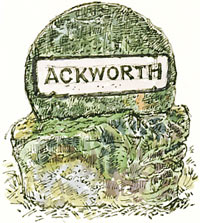 the sort of inconsequential detail that I think works better in a drawing than
in a photograph. There can be a friendly softness about a drawing, while a photograph
can have a documentary aloofness to it.
the sort of inconsequential detail that I think works better in a drawing than
in a photograph. There can be a friendly softness about a drawing, while a photograph
can have a documentary aloofness to it.
The millstone sign for Ackworth village (right) probably
wouldn't even register as you entered the parish driving at 40 miles per hour
along the A-road but when you're walking you have the time, if you're so inclined,
to take in such details.
For me it raises questions such as 'where did that millstone come
from?' or 'did the much-weathered boundary stone that it is mounted on have
some previous use or significance?'
I can have a stab at answering such questions in my own parish,
as I've absorbed bits and pieces of its history over the years, but I'd have
difficulty researching the answers in a parish I'm not familiar with, such as
here in Ackworth.
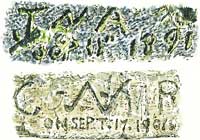
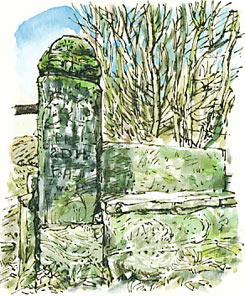 Old
Stile
Old
Stile
I like objects that have a history, even if I can't find out everything
about that history. In fact a little bit of mystery makes them all the more
intriguing. For instance, the Victorian graffiti on this stone stile; a little
research reveals that the 11th September 1891 was a Friday and that the 17th
September 1901 was a Tuesday. We will probably never know who 'J N A'
or 'C N P' were. I guess that in both cases a man carved the initials
so we might be looking for a 'John' and a 'Charles' with their respective sweethearts
being an 'Alice' or an 'Anne' and a 'Pauline' or 'Patricia'.
Queen Victoria died on the 22nd of January 1901, so these two
dates straddle the end of an era. Presumably our 'John' was too old to have
volunteered to serve in the 1914-1918 war, although he could conceivably have
served in the Boer War. Was our 'Charles' called up? If so, did he become a
casualty in the trenches or did he return to his 'Pauline'?
If they did marry, perhaps there are surviving grandchildren who
remember them well. But there it is anyway; as you cross the stile, a little
reminder of the first long summer of the Edwardian era.
 Ridge
and Furrows
Ridge
and Furrows
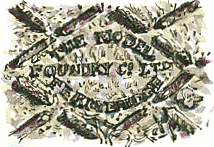 I've
been drawing these from the photographs that I took on the 11th
March. For information, the photographs would have been fine, but I prefer
these simple pen and wash drawings because the fact that I have thought them
worth drawing hints at the interest that I felt when I walked up the track towards
the ridge of Castle Syke Hill for the first time.
I've
been drawing these from the photographs that I took on the 11th
March. For information, the photographs would have been fine, but I prefer
these simple pen and wash drawings because the fact that I have thought them
worth drawing hints at the interest that I felt when I walked up the track towards
the ridge of Castle Syke Hill for the first time.
More lettering in the landscape; this time in a manhole cover
on Castle Syke Hill which was cast at 'The Model Foundry Co. Ltd., Ferrybridge'.
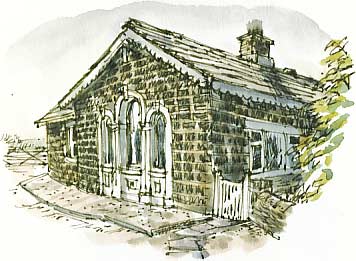
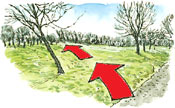 Here's
the entrance lodge at Purston Jaglin that I photographed as I mapped out my
walk in March. I like to include distinctive places that serve to confirm to
walkers that they're on the right track. I was able to pick up a few facts about
this and other places on the walk by chatting to the locals.
Here's
the entrance lodge at Purston Jaglin that I photographed as I mapped out my
walk in March. I like to include distinctive places that serve to confirm to
walkers that they're on the right track. I was able to pick up a few facts about
this and other places on the walk by chatting to the locals.
It often happens that the most difficult part of a walk to describe
is the first bit; getting people out of the car park and heading off in the
right direction. Once you've done that on this walk you've got a mile of open
country walking towards the ridge - easy - but you try telling people how to
get out of a park! You can't just say 'turn left at the next tree.' In this
case I thought it was worth including a vignette of the point where you leave
the path around the park and head off up the slope.
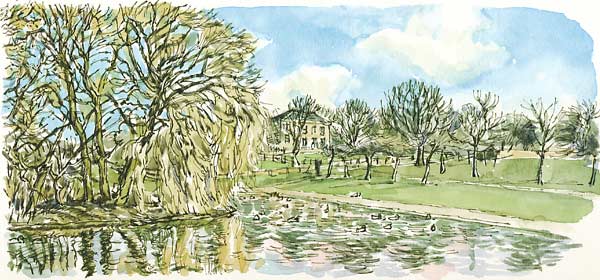
Purston Park
Parks are a real asset to the area but while in the current election
campaign we've heard about the need to protect frontline services such as health
and education, I've never heard anyone promising to protect the green spaces
budget, although I'd argue that they can make a huge contribution to our health,
our continuing well-being and our general background levels of happiness. Unlike
exam results and waiting times for operations, you can't conveniently express
the contentment generated by parks as a statistic. Drawing Purston Park for
my book somehow underlines its importance for me. When I was there
I was so concerned with finding my path that I didn't really relax and simply
enjoy the place.
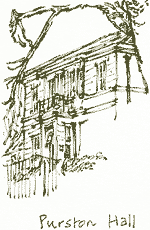 Getting
things in proportion
Getting
things in proportion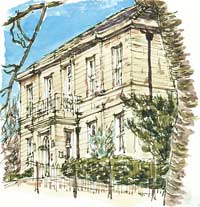
Finally, a little about the pitfalls of drawing from photographs.
I've got a scary amount of landscape vignettes to draw for my walks book over
the next 6 weeks, I guess about 150 of them, so I decided to try and keep the
size of each one quite small. For Purston Hall (left), I started by
drawing the branch framing the view to restrict the size of the eventual drawing.
This proved to be a bit too small for comfortably fitting in the architectural
detail so I abandoned it and started again, this time drawing the facade of
the house, top left to bottom right (since I'm right-handed) at a slightly larger
scale.
Again it was by settling down to draw the hall that I realised
what a gem of a building it is. If time was no object I'd go back and make a
study of the carved stone details around that central upper window. The hall
dates from the Regency period, roundabout 1830.
previous | home
page | this month | e-mail
richard | next
 ANOTHER
MILESTONE, and while I admit you wouldn't want to go far out of your way to
see something like this, I think it conjures up a little of the pleasure of
getting out on a walk and seeing such common objects of the countryside; things
that have been around for a while and which add character to a particular place;
ANOTHER
MILESTONE, and while I admit you wouldn't want to go far out of your way to
see something like this, I think it conjures up a little of the pleasure of
getting out on a walk and seeing such common objects of the countryside; things
that have been around for a while and which add character to a particular place; the sort of inconsequential detail that I think works better in a drawing than
in a photograph. There can be a friendly softness about a drawing, while a photograph
can have a documentary aloofness to it.
the sort of inconsequential detail that I think works better in a drawing than
in a photograph. There can be a friendly softness about a drawing, while a photograph
can have a documentary aloofness to it.
 Old
Stile
Old
Stile Ridge
and Furrows
Ridge
and Furrows I've
been drawing these from the photographs that I took on the
I've
been drawing these from the photographs that I took on the 
 Here's
the entrance lodge at Purston Jaglin that I photographed as I mapped out my
walk in March. I like to include distinctive places that serve to confirm to
walkers that they're on the right track. I was able to pick up a few facts about
this and other places on the walk by chatting to the locals.
Here's
the entrance lodge at Purston Jaglin that I photographed as I mapped out my
walk in March. I like to include distinctive places that serve to confirm to
walkers that they're on the right track. I was able to pick up a few facts about
this and other places on the walk by chatting to the locals.
 Getting
things in proportion
Getting
things in proportion